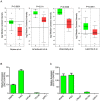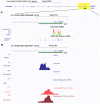Association of DSC3 mRNA down-regulation in prostate cancer with promoter hypermethylation and poor prognosis
- PMID: 24664224
- PMCID: PMC3963953
- DOI: 10.1371/journal.pone.0092815
Association of DSC3 mRNA down-regulation in prostate cancer with promoter hypermethylation and poor prognosis
Abstract
Background: Desmocollin 3 (DSC3), a member of the cadherin gene superfamily, is associated with pathogenesis of some cancers, but its role in prostate cancer (PCa) remains largely unknown.
Methods: DSC3 gene expression level in available PCa microarray dataset was examined using the Oncomine database. DSC3 transcript expression in prostate cell line panel and an independent tissue cohort (n = 52) was estimated by quantitative PCR (Q-PCR). Epigenetic status of DSC3 gene promoter in PCa was investigated by uploading three dataset (ENCODE Infinium 450K array data and two methylation sequencing) in UCSC genome browser. While pyrosequencing analysis measured promoter DNA methylation, Q-PCR estimates were obtained for DSC3 transcript re-expression after 5-Aza-deoxycytidine (5-Aza) treatment. Clinical relevance of DSC3 expression was studied by Kaplan-Meier survival analysis. Finally, functional studies monitoring cell proliferation, migration and invasion were performed in prostate cell lines after siRNA mediated DSC3 knockdown or following 5-Aza induced re-expression. EMT markers Vimentin and E-cadherin expression was measured by Western Blot.
Results: Microarray data analyses revealed a significant decrease in DSC3 transcript expression in PCa, compared to benign samples. Q-PCR analysis of an independent cohort revealed DSC3 transcript down-regulation, both in PCa cell lines and tumor tissues but not in their benign counterpart. Examination of available NGS and Infinium data identified a role for epigenetic regulation DSC3 mRNA reduction in PCa. Pyrosequencing confirmed the increased DSC3 promoter methylation in cancer cell lines and restoration of transcript expression upon 5-Aza treatment further corroborated this epigenetic silencing mechanism. Importantly Kaplan-Meier analysis of an outcome cohort showed an association between loss of DSC3 expression and significantly increased risk of biochemical recurrence. Functional studies indicate a role for epithelial-mesenchymal transition in DSC3 regulated cell migration/invasion.
Conclusion: Taken together, our data suggests that DNA methylation contributes to down-regulation of DSC3 in prostate cancer, and loss of DSC3 predicts poor clinical outcome.
Conflict of interest statement
Figures





References
-
- Siegel R, Naishadham D, Jemal A (2013) Cancer statistics, 2013. CA Cancer J Clin 63: 11–30. - PubMed
-
- Choudhury AD, Eeles R, Freedland SJ, Isaacs WB, Pomerantz MM, et al. (2012) The role of genetic markers in the management of prostate cancer. Eur Urol 62: 577–587. - PubMed
-
- Salagierski M, Schalken JA (2012) Molecular diagnosis of prostate cancer: PCA3 and TMPRSS2:ERG gene fusion. J Urol 187: 795–801. - PubMed
-
- Borno ST, Fischer A, Kerick M, Falth M, Laible M, et al. (2012) Genome-wide DNA methylation events in TMPRSS2-ERG fusion-negative prostate cancers implicate an EZH2-dependent mechanism with miR-26a hypermethylation. Cancer Discov 2: 1024–1035. - PubMed
Publication types
MeSH terms
Substances
LinkOut - more resources
Full Text Sources
Other Literature Sources
Medical
Miscellaneous

